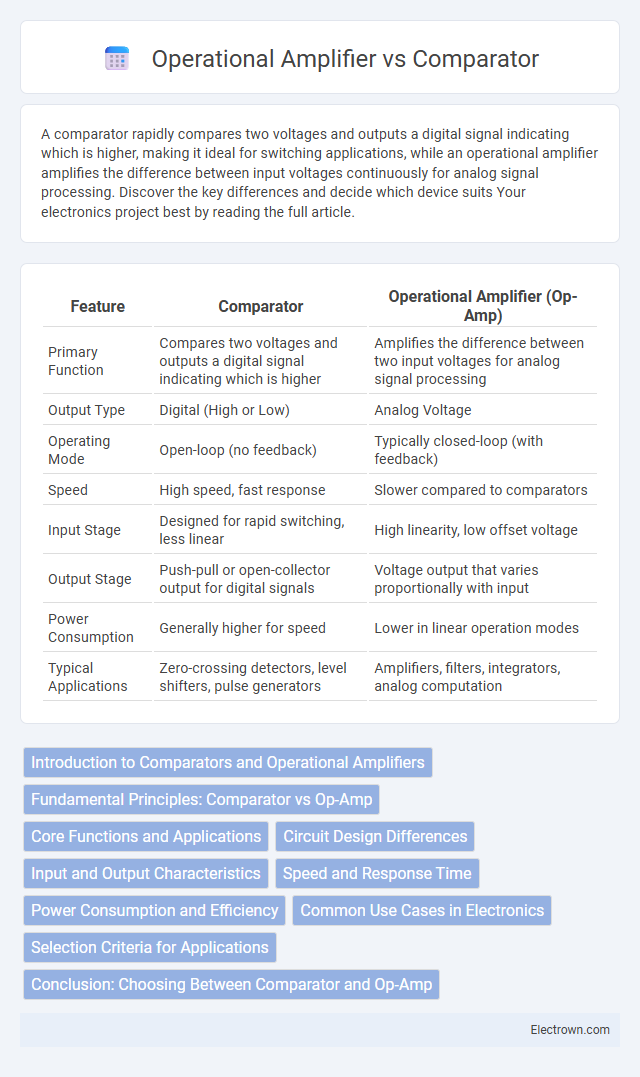A comparator rapidly compares two voltages and outputs a digital signal indicating which is higher, making it ideal for switching applications, while an operational amplifier amplifies the difference between input voltages continuously for analog signal processing. Discover the key differences and decide which device suits Your electronics project best by reading the full article.
Table of Comparison
| Feature | Comparator | Operational Amplifier (Op-Amp) |
|---|---|---|
| Primary Function | Compares two voltages and outputs a digital signal indicating which is higher | Amplifies the difference between two input voltages for analog signal processing |
| Output Type | Digital (High or Low) | Analog Voltage |
| Operating Mode | Open-loop (no feedback) | Typically closed-loop (with feedback) |
| Speed | High speed, fast response | Slower compared to comparators |
| Input Stage | Designed for rapid switching, less linear | High linearity, low offset voltage |
| Output Stage | Push-pull or open-collector output for digital signals | Voltage output that varies proportionally with input |
| Power Consumption | Generally higher for speed | Lower in linear operation modes |
| Typical Applications | Zero-crossing detectors, level shifters, pulse generators | Amplifiers, filters, integrators, analog computation |
Introduction to Comparators and Operational Amplifiers
Comparators and operational amplifiers (op-amps) are fundamental analog components used in electronic circuits. Comparators are designed to compare two voltage levels and output a digital signal indicating which input is higher, whereas operational amplifiers amplify the difference between two input voltages and provide a continuous analog output. Understanding the distinct operational modes and applications of your comparator and op-amp is crucial for selecting the right device in signal processing and control systems.
Fundamental Principles: Comparator vs Op-Amp
A comparator operates by rapidly switching its output to indicate which input voltage is higher, functioning as a binary decision device without feedback. An operational amplifier, designed for linear amplification, uses negative feedback to stabilize gain and produce an output proportional to the difference between its inputs. Your choice between a comparator and an op-amp depends on whether you require fast, discrete switching or precise, continuous signal amplification.
Core Functions and Applications
Comparators and operational amplifiers serve distinct core functions: comparators output a digital signal indicating which input voltage is higher, ideal for zero-crossing detectors and threshold-level triggers, while operational amplifiers amplify analog signals for tasks like signal conditioning and filtering. Your choice depends on application needs--comparators excel in fast, binary decision-making circuits, whereas operational amplifiers are better suited for precision analog signal processing. Understanding these roles ensures optimal performance in electronics design.
Circuit Design Differences
Comparators and operational amplifiers differ significantly in circuit design, with comparators optimized for fast switching between output states and lack of feedback components, while operational amplifiers use negative feedback loops for linear amplification. The input stage of a comparator is designed for rapid response to input voltage differences, whereas an operational amplifier's input stage emphasizes high gain and stability for analog signal processing. Understanding these design differences helps you select the appropriate device for applications requiring either precise voltage comparison or accurate signal amplification.
Input and Output Characteristics
A comparator features a high gain open-loop configuration designed to switch its output between saturation levels based on input voltage differences, making it ideal for binary decision applications. Operational amplifiers, however, have a high input impedance and produce a continuous output voltage proportional to the input differential, perfect for analog signal amplification. Understanding your circuit requirements helps determine whether the comparator's digital output or the operational amplifier's linear response best suits your design needs.
Speed and Response Time
Comparators typically exhibit faster speed and shorter response times than operational amplifiers due to their design, which prioritizes rapid switching over linear amplification. While op-amps have higher gain bandwidth products optimized for signal integrity in linear circuits, comparators switch output states rapidly, often in nanoseconds, making them ideal for threshold detection. The response time of comparators is a critical parameter in applications like analog-to-digital converters and pulse-width modulation, where speed is crucial for accurate performance.
Power Consumption and Efficiency
Comparators generally consume less power than operational amplifiers (op-amps) because they are designed for rapid switching rather than continuous analog signal processing, making them highly efficient for digital decision-making applications. Operational amplifiers, while versatile in amplification and filtering tasks, typically have higher quiescent current and power dissipation due to their linear operation and feedback configurations. In battery-powered or low-power systems, choosing a comparator can significantly enhance power efficiency without compromising speed in threshold detection tasks.
Common Use Cases in Electronics
Comparators are widely used in electronic circuits for voltage level detection, zero-crossing detectors, and pulse-width modulation due to their ability to quickly switch output states in response to input voltage differences. Operational amplifiers excel in signal amplification, filtering, and analog computation, providing precise gain control and linear response for audio equipment, instrumentation, and control systems. Understanding the distinct applications of comparators and operational amplifiers allows you to select the right component for tasks involving threshold detection or signal conditioning.
Selection Criteria for Applications
Choosing between a comparator and an operational amplifier (op-amp) depends on speed, precision, and output requirements. Comparators excel in high-speed switching with sharp output transitions, making them ideal for digital signal detection and threshold monitoring. Op-amps provide linear amplification with low offset and noise, suitable for analog signal conditioning and feedback control applications.
Conclusion: Choosing Between Comparator and Op-Amp
Choosing between a comparator and an operational amplifier depends on your application's requirements for speed, precision, and output behavior. Comparators are ideal for fast, binary signal decisions with open-drain or open-collector outputs, while operational amplifiers excel in linear, analog signal processing with high gain and feedback control. Your selection should align with whether you need precise threshold detection or continuous signal amplification.
Comparator vs operational amplifier Infographic

 electrown.com
electrown.com